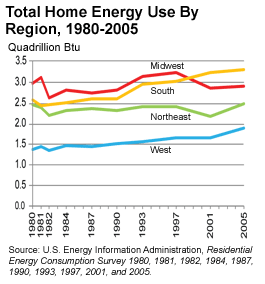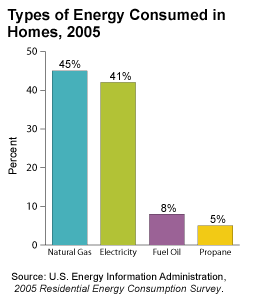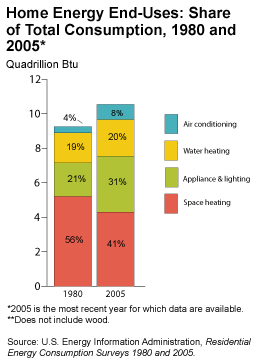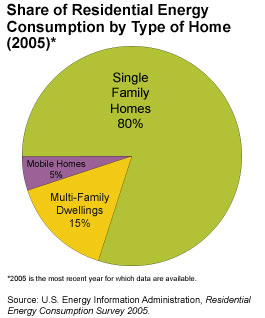At Home
Using & Saving Energy In Homes
What uses more energy in our homes — heating, cooling, lighting, or powering electronics like TVs, computers, and MP3 players? And, do houses in the United States use more electricity or natural gas?
In Homes Basics
The ability to heat and cool is one important accomplishment of modern technology. Our ovens, freezers, and homes can be kept at any temperature we choose, a luxury that wasn't possible 100 years ago. But keeping our homes comfortable uses a lot of energy. Did you know that more than 50 percent of your monthly bill goes to heating and cooling your home?
Most homes still use the traditional incandescent bulbs invented by Thomas Edison. These bulbs convert only about 10% of the electricity they use into light; the other 90% is converted into heat.
Compact fluorescent bulbs, or "CFLs," have made inroads into home lighting systems in the last few years. These bulbs last much longer and use much less energy than incandescent bulbs, producing significant savings over the life of the bulb.
Appliances such as refrigerators, washing machines, and dryers are also more energy efficient than they used to be. Congress passed the National Appliance Energy Conservation Act in 1990 that requires new appliances to meet strict energy efficiency standards. Learn what it means to be energy efficient.
Most of the energy used in homes is for space heating (41%), followed by electronics, lighting and other appliances (26%), water heating (20%), air conditioning (8%), and refrigeration (5%).
It is increasingly common for homes to use multiple televisions and computers. Additionally, the home electronics market is constantly innovating, and new products such as DVRs, game systems, and rechargeable electronic devices are becoming ever more integral to our modern lifestyle. As a result of these changes, appliances and electronics (including refrigerators) now account for nearly one-third of all energy used in homes.
Types of Energy Used In Homes
Natural gas is the most-consumed energy source in U.S. homes, followed by electricity, heating oil, and propane. Many homes in rural areas use propane for heating, while others use it to fuel their barbecue grills.
ENERGY AND FUEL USE DEFINES OUR CARBON FOOTPRINT:
A carbon footprint has historically been defined as "the total set of greenhouse gas (GHG) emissions caused by an organization, event, product or person.
Resources for more information:
Gains in Home Energy Efficiency Offset by More Electronics and Appliances
Total residential energy consumption has varied between 9.5 and 10.5 quadrillion Btu over the past 30 years. During the same period, U.S. population grew by 30% and there were 39 million new home starts, but consumption grew at a slower rate, due to improvements in building insulation and efficiencies of heating and cooling equipment, water heaters, refrigerators, and other major appliances. However, these efficiency gains were offset by increases in the number of homes with cooling equipment, clothes washers and dryers, and dishwashers. Additionally, a growing number of U.S. households now have multiple televisions, computers, and refrigerators.
Use of Consumer Electronics Increasing
While most home appliances have become more efficient over the past 30 years, the average U.S. household uses many more consumer electronics — in particular, personal computers, televisions and related devices.
DVD players and Digital Video Recorders (DVR), which did not exist 15 years ago, are now widespread. As of 2009, 79% of homes had a DVD player, and 43% had a DVR. Nearly a third of all households also had at least four electronic devices, such as cell phones, plugged in and charging at home.
Air-Conditioning Equipment Becomes Increasingly Common
The percentage of homes with central air-conditioning has more than doubled since 1980, with more than 60% of homes having a central system. All areas of the United States show a significant increase in air-conditioning equipment and use in recent years. Cooling now accounts for about 8% of total residential end use energy consumption in the United States, double its 1980 share. Except in the temperate climate regions along the West coast, air conditioners (AC) are now standard equipment in about 87% of U.S. homes.
Single Family Townhomes
Energy Use in Different Types of Homes
About 80% of residential energy use is consumed in single-family homes, while 15% is consumed in apartments and 5% is consumed in mobile homes. These different home types, along with variation in home size, structure, climate, and vintage, contribute to the diversity in energy use in homes across the United States.
Single-Family Homes:
More than half of single-family homes use natural gas for space heating, while about one-quarter use electricity. Most single-family homes use three or more televisions and almost all single-family homes use a clothes washer and dryer.
In 2009, for main space heating equipment:
54% used natural gas
28% used electricity
6% used fuel oil
6% used propane/LPG
Some houses don't use heat at all
For appliances and electronics:
96% used a clothes washer
94% used a clothes dryer
81% used a computer
67% used a dishwasher
53% used three or more televisions
In 2009, for main space heating equipment:
43% used electricity
42% used natural gas
6% used fuel oil
Almost none used propane/LPG
In 2009, for main space heating equipment:
57% used electricity
20% used natural gas
12% used propane/LPG
Eighty-four percent of mobile homes have air conditioning (central system, wall/window units, or both).
For appliances and electronics:
90% used a clothes washer
83% used a clothes dryer
52% used a personal computer
36% used three or more televisions
33% used a dishwasher
Source: U.S. Energy Information Administration.








